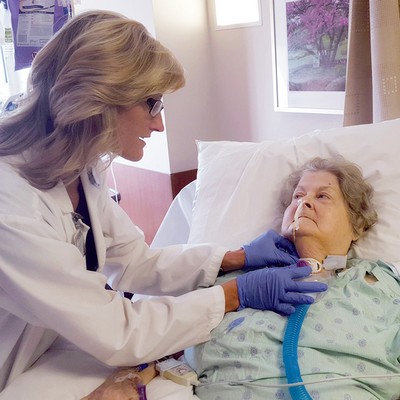Current Research Related to Mechanical Ventilation and Speaking Valve Use
Megan Brogan, MS, CFY-SLP, Kristin King, PhD, CCC-SLP

- Freeman-Sanderson, A.L., Togher, L., Elkins, M.R., and Phipps, P.R. (2016). Quality of life improves with return of voice in tracheostomy patients in intensive care: an observational study. Critical Care Medicine, 33:186, (Epub 2016 Jan 13).
Current research shows an overwhelming association of negative emotions, including fear, anxiety and depression with patients admitted to the intensive care unit (ICU). Statistics report up to 75% of patients report anxiety and 40% report depressive symptoms following admission to ICU (Nelson et al. 2001).
These investigators conducted a prospective, observational study of 22 patients in a tertiary ICU, to evaluate the effects of vocal communication on mental and physical wellness. The study measured patient-reported change of mood, communication-related quality of life, and general health status with return of voice among mechanically ventilated tracheostomy patients admitted to the ICU. Daily evaluations were conducted to assess patients’ quality of life in relation to communication, and weekly evaluations were conducted to assess their general health status. All participants had undergone a tracheostomy and experienced voicelessness during mechanical ventilation. Patients progressed through cuff deflation, assessment/management of swallowing, and a communication assessment, which included implementation of the Passy Muir® Speaking Valve.
Results collected from both daily and weekly data of patients in the ICU concluded that patients’ self-esteem and mood directly coincided with regaining function of voice after the tracheostomy; specifically, improvement was seen in the ability to be understood by others and the patient’s cheerfulness. The authors also suggested that functional use of the voice may be associated with a positive change in health and rehabilitation, however, the authors recommend that more research is needed to investigate this relationship.
- Sutt, A., Caruana, L.R., Dunster, K.R., Cornwell, P.L., Anstey, C.M., and Fraser, J.F. (2016). Speaking valves in tracheostomised ICU patients weaning off mechanical ventilation – do they facilitate lung recruitment? Critical Care, 20: 91. doi:10.1186/s13054-016-1249-x
Research has shown that patients who require positive pressure ventilation through a tracheostomy tube are unable to phonate due to the inflated tracheostomy cuff (Grossbach, Stranberg, Chlan, 2011). Use of a speaking valve with patients who are mechanically ventilated has been inhibited due to the concern that there is potential risk of harming the patients’ already-compromised lungs during their recovery duration in the ICU.
To further assess the effects of speaking valve use on phonation, researchers Sutt et al. conducted a prospective observational study of 20 consecutive tracheostomized patients in the cardio-thoracic adult ICU, all weaning from mechanical ventilation while also using a Passy Muir Speaking Valve. The study evaluated End Expiratory Lung Impedance (EELI) and standard bedside respiratory parameters of these patients, before, during and after the use of a Passy Muir Speaking Valve.
Results from the study yielded important information regarding the potential for positive effects of in-line speaking valve use during the weaning process from a ventilator. An increase in EELI was observed following use of the Passy Muir bias closed position speaking valve. EELI was also observed to maintain and further increase for at least 15 minutes following the removal of the speaking valve from the ventilation circuit. These findings suggest there to be no evidence of significant de-recruitment of the lungs from use of the speaking valve while weaning from mechanical ventilation. Speaking valve use resulted in a reduced respiratory rate and reduced end-tidal CO2 when used in tracheostomized cardiothoracic ICU patients weaning from mechanical ventilation.
- Fernandez-Carmona, F., Diaz, M.A., Alonso, E.A., Guarasa, I.M., Lopez, P.M., and Castellanos, M.A. (2015). Use of speaking valve on preventing respiratory infections, in critical traqueostomized patients diagnosed of dysphagia secondary to artificial airway. edisval study. Intensive Care Medicine Experimental, 3(Suppl 1):A936. http://www.icm-experimental.com/content/3/S1/A936
Research has demonstrated that patients with prolonged use of tracheostomized mechanical ventilation have a high prevalence of dysphagia and respiratory infections. The use of speaking valves allows for re-establishment of the patient’s upper airway, facilitating rehabilitation from these dysfunctions, as well as recovery of deglutition and phonation. This article used a randomized multicenter controlled clinical trial to determine the usefulness of a speaking valve in preventing respiratory nosocomial infections in critical tracheostomized patients diagnosed with dysphagia secondary to artificial airway.
The study included a randomized selection of speaking valve use for 27 patients (+18 years) on mechanical ventilation with a diagnosis of dysphagia secondary to an artificial airway, 19 of whom were included in the final data analysis. The use of the speaking valve was implemented during the mechanical ventilation weaning-decannulation phase while in ICU. Results from the study concluded patients with speaking valve use:
- Were decannulated, on average, 2 days prior to the non-speaking valve group.
- Displayed decreased incidence of respiratory infectious complications and mortality as compared to the non-speaking valve use group. The mortality rate was 0 for patients using the speaking valve and 3 for patients without use of the speaking valve.
As this was an Edisval study, the authors continue to collect data on both groups.
- Rodrigues, K.A., Machado, F.R., Chiari, BM., Rosseti, H.B., Lorenzon, P., and Goncalves, MIR. (2015). Swallowing rehabilitation of dysphagic tracheostomized patients under mechanical ventilation in intensive care units: a feasibility study. Revista Brasileira de Terapia Intensiva, 27(1): 64-71.
A prospective, non-controlled, intervention study was conducted to evaluate the effects of early identification and implementation of swallowing rehabilitation in tracheostomized patients with mechanical ventilation, recovering from dysphagia. The study assessed 14 stable patients from 7 different intensive care units, all under mechanical ventilation for at least 48 hours, following 48 hours of tracheostomy.
The patients participated in a swallowing rehabilitation program with use of a Passy Muir® speaking valve in every rehabilitation session. The mean duration of the rehabilitation program was 12.4 ± 9.4 days, with 5.0 ± 5.2 days under mechanical ventilation. The sessions consisted of a variety of therapeutic strategies, including mobility exercises, sensory motor integration, and swallowing maneuvers, all implemented to restore swallowing function. Patient progress was assessed with an oropharyngeal structural score, swallowing functional score, and an otorhinolaryngological structural and functional score, which were collected both prior to and following swallowing therapy.
All participant scores positively reflected significant improvement following swallowing therapy. Out of the 14 individuals included in the study, 11 patients made enough progress within just 4 days of initiation of swallowing therapy to receive oral feedings during the duration of their stay in the intensive care unit. While this study was conducted on a limited population, it successfully identified and demonstrated the feasibility of early implementation of a swallowing rehabilitation program for patients under mechanical ventilation with a Passy Muir Speaking Valve in use.
- Egbers, P.H., Bultsma, R., Middelkamp, H., and Boerma, E.C. (2014). Enabling speech in ICU patients during mechanical ventilation. Intensive Care Medicine, 40: 1057 – 1058. doi:10.1007/s00134-014-3315-7
In this letter to the editor, the authors address the significant impact that mechanical ventilation has on the psycho-emotional function of patients in the ICU. According to research, the inability to speak during mechanical ventilation increases psycho-emotional distress for patients during ICU treatment and is more prominent in patients with a prolonged weaning period (Khalaila et al., 2011). The purpose of their letter is to encourage intensive care personnel to develop weaning protocols that include the use of a one way speaking valve, specifically the Passy Muir® Valve, to help with communication and weaning. In supporting their argument, they share the results from a 2013 study which measured outcomes during a weaning protocol using the one way Passy Muir Speaking Valve with mechanical ventilation.
In 2013, Egbers at al. conducted a study to evaluate the effects of cuff-deflated mechanical ventilation, in combination with a high flow non-invasive ventilator and a one-way tracheostomy speaking valve, on the speech of 24 tracheostomized patients in a mixed medical-surgical ICU. To allow expiratory flow to pass through the oropharyngeal route, a Passy Muir Speaking Valve was implemented to enhance speech.
Air leakage was present within 24 hours after the tracheotomy procedure after deflation of the cuff. Invasive pressure support ventilation was replaced by a BiPAP mode with a non-invasive ventilator (BiPAP Vision, Philips, Best, the Netherlands) at equal ventilator settings. Implementation of the BiPAP setting resulted in all 12 patients being able to speak within the first day. The quality and duration of speech was measured to improve over time with a median time, from the beginning of speech to the end of mechanical ventilation, being 12 (+/-) 6 days. Effective weaning from mechanical ventilation was achieved in all patients by progressive intervals of CPAP.
The study concluded that patients’ speech following difficult weaning of tracheostomies in the ICU may effectively be restored by cuff-deflated non-invasive BiPAP ventilation in combination with use of a Passy Muir Speaking Valve.
- Hoffman, L., Bolton, J., and Ferry, S. (2009). Passy Muir Speaking Valve Use in a Children’s Hospital: An Interdisciplinary Approach. Perspectives: ASHA, 76-86.
The general purpose of a tracheostomy tube is to compensate for respiratory function via mechanical ventilation to overcome deficits of the pediatric patient’s airway. While this is extremely important for the child’s health, it also creates potential developmental deficits if used on a long-term basis. During exhalation, the tracheostomy tube redirects air away from the vocal folds making phonation very difficult to produce. In the young pediatric population, research has shown that the presence of a tracheostomy tube can interfere with the development of early communication interactions and subsequent speech and language development (Jackson & Albamonte, 1994).
To avoid detrimental development during implementation of a tracheostomy tube in the pediatric population, speaking valves can be used to restore speech function and promote appropriate development. According to the authors, the Passy Muir Speaking Valve (PMV®) is used “almost exclusively” at the The Children’s Hospital of Philadelphia (CHOP). While speaking valves are used in both the adult and pediatric populations, successful use often proves to be more difficult in the pediatric population. Infant and pediatric tracheal size differs in proportion from the mature airway. Pediatric and infant patients have small airways requiring smaller, yet tighter fitting tracheostomy tubes, reducing the available air leak around the tracheostomy tube necessary for speaking valve success (Jackson & Albamonte, 1994). The PMV is fitted to promote successful function of airflow for both adult and pediatric patients.
The authors also review the effects of the PMV on restoring subglottic pressure to decrease risk of aspiration. Evidence suggests the key mechanism responsible for aspiration is decreased subglottic air pressure, which can be restored with use of a speaking valve (Suiter et al.). Another concern of long-term use of tracheostomy tubes is dysfunctional or paradoxical true vocal fold movement. The authors suggest that current research findings report that long periods of time without airflow around the vocal folds also may result in increased prevalence of dysfunctional or paradoxical true vocal fold movement (Iskowitz, 1998). The PMV is designed to allow for maximal redirection of air around the tracheostomy tube and over the vocal folds during exhalation at the resting- closed position. This design benefits the patient by providing opportunities for vocalization and speech that resembles a normal pattern (Kaut, Turcott, & Lavery, 1996).
The authors write in conclusion that interdisciplinary collaboration is essential for pediatric patients to receive optimal benefit from the PMV. The authors state that with the collaboration of the unique skills of speech-language pathologists, respiratory therapists, physicians, and nurses, a systematic and safe method for identifying, evaluating, and implementing successful use of the PMV can be achieved.
This article is from Volume 6 Issue 1 of Talk Muir Fall 2016. Click here to view Current Research Related to Mechanical Ventilation and Speaking Valve Use.












